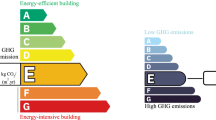Abstract
Buildings are responsible for 40% of the energy consumption and around 36% of CO2 emissions in the European Union. Administrations are funding projects enhancing energy efficiency to achieve a zero-emission building. As a consequence, many companies perceive the business potential. Several public buildings are analyzed by comparing their energy rating labels against their real energy consumption. Results show that highly rated buildings are also the ones with higher consumption. This study analyzes and discusses the factors that end up in this paradox. Results show that new buildings consume more energy, which is caused by higher interior-comfort standards. Moreover, control systems that should warrant optimal functionality of the building consume non-negligible amounts of energy. Finally, technical exigencies on buildings have increased in recent years. In conclusion, project management should incorporate the structure, control, security, and comfort systems together in the design phase. Moreover, this phase should also include the operating definition of the building during the day and throughout seasons of the year.
Access this chapter
Tax calculation will be finalised at checkout
Purchases are for personal use only
Similar content being viewed by others
References
Atmaca A, Atmaca N (2015) ‘Life cycle energy (LCEA) and carbon dioxide emissions (LCCO2A) assessment of two residential buildings in Gaziantep, Turkey. Energy and Build 102:417–431. https://doi.org/10.1016/j.enbuild.2015.06.008
Iten M, Liu S, Shukla A (2016) A review on the air-PCM-TES application for free cooling and heating in the buildings. Renew Sustain Energy Rev 61:175–186. https://doi.org/10.1016/j.rser.2016.03.007
Jevons WS (1866) The coal question; an inquiry concerning the progress of a nation and the probable exhaustion of our coal mines. Macmillan and Co. https://doi.org/10.1093/library/s5-XVII.3.238
Pérez-Lombard L, Ortiz J, Pout C (2008) A review on buildings energy consumption information. Energy Build 40(3):394–398. https://doi.org/10.1016/j.enbuild.2007.03.007
Praseeda KI, Reddy BVV, Mani M (2016) Embodied and operational energy of urban residential buildings in India. Energy Build 110:211–219. https://doi.org/10.1016/j.enbuild.2015.09.072
Ramesh T, Prakash R, Shukla KK (2010) Life cycle energy analysis of buildings: an overview. Energy Build 42(10):1592–1600. https://doi.org/10.1016/j.enbuild.2010.05.007
Rong H et al (2016) Optimizing energy consumption for data centers. Renew Sustain Energy Rev 58:674–691. https://doi.org/10.1016/j.rser.2015.12.283
Whitehead B et al (2015) Assessing the environmental impact of data centres part 2: building environmental assessment methods and life cycle assessment. Build Environ 93:395–405. https://doi.org/10.1016/j.buildenv.2014.08.015
Worldbank (2014) Electric power transmission and distribution losses. http://data.worldbank.org/indicator/EG.ELC.LOSS.ZS. Accessed: 15 Jan 2016
Acknowledgments
Authors appreciate the contribution of the UPC and the REFER project (COMRDI15-1-0036) from ACCIÓ with European Regional Development Fund (ERDF).
Author information
Authors and Affiliations
Corresponding authors
Editor information
Editors and Affiliations
Rights and permissions
Copyright information
© 2021 Springer Nature Switzerland AG
About this paper
Cite this paper
Macarulla, M., Canals Casals, L. (2021). Paradoxes Between Energy Labeling and Efficiency in Buildings. In: Ayuso Muñoz, J.L., Yagüe Blanco, J.L., Capuz-Rizo, S.F. (eds) Project Management and Engineering Research. Lecture Notes in Management and Industrial Engineering. Springer, Cham. https://doi.org/10.1007/978-3-030-54410-2_26
Download citation
DOI: https://doi.org/10.1007/978-3-030-54410-2_26
Published:
Publisher Name: Springer, Cham
Print ISBN: 978-3-030-54409-6
Online ISBN: 978-3-030-54410-2
eBook Packages: EngineeringEngineering (R0)




